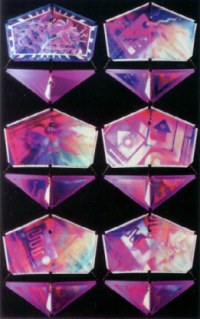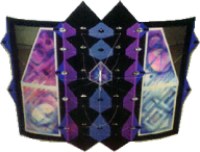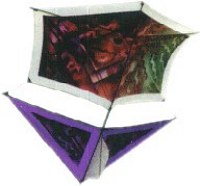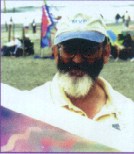Like many other I enjoyed the mysteries of kites as a child and spent many hours flying my Jolly Roger kite. Each year that simple "eddy kite" had to be a Jolly Roger, and it seemed to fly better then any other kite in the neighborhood. As the years went by, my interests and demands moved elsewhere. As an adult I did make a couple of kites, but I always felt uncomfortable going out to fly them. After all, that was kid stuff!
 |
What brought me back into kiting was discovering the magic of stunt kites. While on a trip about eight years ago to one of my art exhibitions I had purchased a small inexpensive stunt kite. I think it I thought that was outrageous at the time. I don't know how many times I dove that kite hard into the ground, but it held up and I learned to fly it reasonably well. What entertainment that was for only 50 dollars! I was hooked and wanted to start building my own kites, but the nearest kite material shop was 600 miles away. My first stunt kite was crude, and made with wooden dowels, vinyl tubing and regular nylon from the fabric store. But the kite did fly. I started looking for books, magazines and sources of supply. Some how I came across Kite Studio and their early publication, Kite Builders International. Now I had some real information and real materials. My first kites were stunt kites, which I still enjoy flying and I occasionally build new ones. |
| My creative need, however, turned me to single line kites. I started with facet or simple cell kites. I then looked for a type of kite on which I could use some of my artistic abilities; after all I was an artist. I wanted a kite that had a lot of surface that could be painted, was an easy flier, but not a real common kite. I found that kite in the Roller. Many of my kites have since become more complicated, and for now I have combined the flat surfaces with celled shapes. |  |
 |
I have only been able to attend two kite events so far. These were the Smithsonian Kite Festival a few years ago and the Washington State International Kite Festival this last year. Fortunately I was able to play a part in the Sky Wind and World Kite Exhibition assembled for the airport in Billings, Montana. The one thing that I found out in my limited exposure to kiting is that kite makers not only make wonderful kites, they are wonderful giving people. |
 |
John Pollock is a Professor of Art at Montana State University-Billings, where he has taught since 1974. Through the years he has established a reputation as an artist by working in the media of lithography and watercolor and has received several awards in both areas. Art works by Mr. Pollock have been published in the American Artist magazine and in two books by Rockport Publishers of Gloucester, MA. The books are titled. The Best of Watercolor 2 and Painting Composition. Numerous art collections also contain his artworks, including the IBM Corporation and the New York City Library Permanent Collection. |